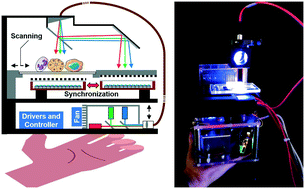High-throughput digital pathology via a handheld, multiplexed, and AI-powered ptychographic whole slide scanner†
Abstract
The recent advent of whole slide imaging (WSI) systems has moved digital pathology closer to diagnostic applications and clinical practices. Integrating WSI with machine learning promises the growth of this field in upcoming years. Here we report the design and implementation of a handheld, colour-multiplexed, and AI-powered ptychographic whole slide scanner for digital pathology applications. This handheld scanner is built using low-cost and off-the-shelf components, including red, green, and blue laser diodes for sample illumination, a modified stage for programmable sample positioning, and a synchronized image sensor pair for data acquisition. We smear a monolayer of goat blood cells on the main sensor for high-resolution lensless coded ptychographic imaging. The synchronized secondary sensor acts as a non-contact encoder for precisely tracking the absolute object position for ptychographic reconstruction. For WSI, we introduce a new phase-contrast-based focus metric for post-acquisition autofocusing of both stained and unstained specimens. We show that the scanner can resolve the 388-nm linewidth on the resolution target and acquire gigapixel images with a 14 mm × 11 mm area in ∼70 seconds. The imaging performance is validated with regular stained pathology slides, unstained thyroid smears, and malaria-infected blood smears. The deep neural network developed in this study further enables high-throughput cytometric analysis using the recovered complex amplitude. The reported do-it-yourself scanner offers a portable solution to transform the high-end WSI system into one that can be made widely available at a low cost. The capability of high-throughput quantitative phase imaging may also find applications in rapid on-site evaluations.

- This article is part of the themed collections: AI in Microfluidics, Miniaturised Sensors & Diagnostics and Lab on a Chip HOT Articles 2022


 Please wait while we load your content...
Please wait while we load your content...